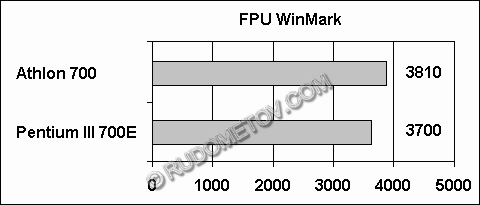Motherboard Abit KT7
Evgenie Rudometov, Victor Rudometov.
authors@rudometov.com
Pattern of system with processor AMD Athlon (Thunderbird)
The motherboard: Abit KT7 (chip set VIA Apollo KT133, processor Socket A plug , standard clock rate of 100 MHz FSB DDR);
The working memory: 128 Mb PC100 SDRAM;
The videoadapter: ASUS AGP-V3800 TV (video chip set TNT2, a video memory of 32 Mb SGRAM, TV-in, TV-out);
The processor: AMD Athlon 700 (700 MHz, kernel Thunderbird, processing technique 0,18 microns, a cache memory memory L1 in size of 128 Kbytes, L2 — 256 Kbytes, a supply voltage of a kernel 1,7 In, konstruktiv PGA, Socket A plug , processor FSB Alpha EV6 bus, standard clock rate of bus FSB makes 100 MHz DDR at data transfer with frequency of 200 MHz);
Hard disk: IBM DPTA-372050 (20 Gbytes, 2 Mb of the cache memory, 7200 rpm, UltraDMA/66);
Power of the power supply: 250 W;
OS: Windows 98 Second Edition;
The test: WinBench 99 (CPUmark 99 and FPU WinMark).
Pattern of system with the processor of Intel of Pentium III (Coppermine)
The motherboard: Abit BE6-II (a chip set i440BX AGPset, processor Slot 1 plug , standard clock rate of 100 MHz FSB);
The working memory: 128 Mb PC100 SDRAM;
The videoadapter: ASUS AGP-V3800 TV (video chip set TNT2, a video memory of 32 Mb SGRAM, TV-in, TV-out);
The processor: Pentium III 700E (700 MHz, kernel Coppermine, processing technique 0,18 microns, a cache memory memory L1 in size of 32 Kbytes, L2 — 256 Kbytes, L2 work on frequency of the processor, a supply voltage of a kernel 1,65 In, konstruktiv FC-PGA, Socket 370 plug , processor FSB AGTL bus +, standard clock rate of bus FSB DDR makes 100 MHz at data transfer with frequency of 100 MHz);
Hard disk: IBM DPTA-372050 (20 Gbytes, 2 Mb of the cache memory, 7200 rpm, UltraDMA/66), processor hooking up to the motherboard was carried out through adapter Slot 1-Socket 370;
Power of the power supply: 250 W;
OS: Windows 98 Second Edition;
The test: WinBench 99 (CPUmark 99 and FPU WinMark).


Parsing the resulted results of testing, it is necessary to remember, that motherboard Abit BE6-II quite often uses as the original measurement standard to which other products are compared. It is linked by that the computers created on the basis of motherboard Abit BE6-II are one of the most efficient. And that fact, that the system on the basis of processor AMD Athlon (Thunderbird) and cards Abit KT7 shows bolshy a performance level, proves not only perspectivity of processors AMD, but also excellence and the successful architecture of appropriate products Abit, and also the electronic units making a basis of the motherboard. First of all it concerns chip sets.
However Abit would be not Abit if has not supported traditions, svjazannyyh with constant implantation of the leading-edge technologies giving wide functionality and high levels of productivity. It is a question of the additional resources providing configuration and convenience of customisation, and also speeding up (overclocking — dispersal) units and computer subsystems. It is reached by possibilities SoftMenu, a supply variation of a kernel of the processor (1,1-1,85 In with step 0,25) and a wide band of possible values of clock rates of the bus of processor Alpha EV6, installed in BIOS Setup (100, 101, 103, 105, 107, 110, 112, 115, 117, 120, 122, 124, 127, 133, 136, 140, 145, 150, 155 MHz).
Estimating perspectives of dispersal of the processor, it is necessary to consider, that the big number of values of frequencies for bus Alpha EV6 has, generally speaking, advertising character. It is linked by that as shows experience, already at clock rate of 117 MHz low stability of system operation is in most cases observed. However, it is necessary to mark, that as absolutely quite good result for motherboards quiescent operation reaching on frequency of bus Alpha EV6 of 110 MHz until recently was considered . But motherboard Abit KT7 concerns for the present rare class of the cards, the built in which resources allow to unblock the frozen frequency coefficients of processors. However it concerns only those cases when bridges L1 on a surface of processors AMD Athlon and AMD Duron remained not intersected in the course of their manufacture and testing by the manufacturer. Otherwise possibilities of dispersal through change of a frequency factor of the processor will be unavailable and it is necessary to be limited either regular modes, or dispersal through increase frequency processor buses.
In conclusion of the given short research it is necessary to pay attention to that fact, that one copy of the motherboard given for rather short time participated in testing only. These obstjatelstva do not allow to do any conclusions about compatibility with a wide spectrum of modern hardware-software resources, and also to judge dependability of operation of cards Abit KT7.
Authors express gratitude to X-Com corporation for given motherboard Abit KT7 and processor AMD Athlon (Thunderbird).
It is published in log "Computer Price"
To pass to razrelu Motherboards and chip sets
 English
English Russian
Russian German
German